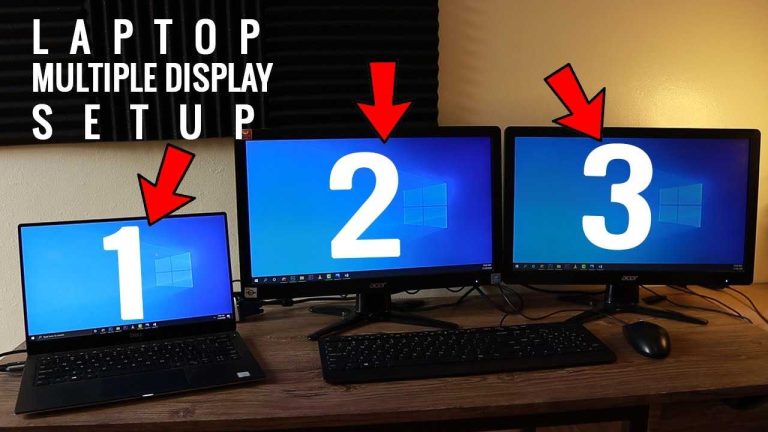To effortlessly set up dual monitors with your docking station, connect each monitor to the designated ports on the dock, then configure your display settings on your computer. Ensure your docking station supports multiple outputs and your laptop’s graphics card can handle dual displays. Once connected, adjust your display preferences to extend or mirror screens as desired for a seamless multitasking experience.
Setting up dual monitors with a docking station can dramatically boost your productivity and create a more immersive workspace. Many users find it confusing to get everything up and running smoothly, especially when connecting different monitor types or troubleshooting display issues. The good news is that with a few simple steps—checking compatibility, connecting the monitors properly, and tweaking your display settings—you can enjoy a dual-screen setup in no time. Whether you’re working from home or at the office, mastering this setup can make your workflow more efficient and comfortable.
How to Run Dual Monitors with Docking Station: A Complete Guide
Understanding the Basics of Dual Monitors and Docking Stations
To set up dual monitors with a docking station, you first need to understand what each component does. A docking station acts as a hub, connecting your laptop to multiple peripherals, including multiple monitors. Dual monitors expand your screen space, making multitasking easier and more efficient.
A typical docking station has various ports such as HDMI, DisplayPort, VGA, and USB-C, which are used to connect external displays. Ensure your laptop supports multiple displays before setting up. Most modern laptops can handle two monitors, but it’s good to verify your device’s specifications.
Check Your Laptop’s Compatibility for Dual Monitors
Before starting, check if your laptop supports dual monitor setups. Review your laptop’s specifications for video output capabilities. Look for information on the maximum number of external displays supported and the supported resolution.
You can find this information in the user manual or on the manufacturer’s website. devices with a dedicated graphics card or multiple video outputs usually handle dual monitors more seamlessly.
Identifying the Ports on Your Docking Station
Docking stations come with various ports designed for different types of connections. Common ports include:
- HDMI
- DisplayPort
- VGA
- USB-C
- USB-A
Make sure your docking station provides enough video output ports for your monitors. For example, if you have two monitors, ensure there are at least two video output options available.
Choosing the Right Cables and Monitors
Select high-quality cables compatible with your monitors and dock. For HD and 4K monitors, use HDMI or DisplayPort cables that support high resolutions and refresh rates. If your monitors have different input types, you might need adapters.
When selecting monitors, consider the resolution, size, and refresh rate that suits your needs. Larger screens or higher resolutions like 4K can improve your productivity and viewing experience.
Connecting Monitors to the Docking Station
Start by turning off your laptop and docking station for safety. Connect your monitors to the docking station using the appropriate cables. Plug the HDMI or DisplayPort cables into the monitors and the other ends into the docking station.
Next, connect the docking station to your laptop via USB-C or Thunderbolt port. Once connected, turn on the monitors and laptop. The operating system should detect the new displays automatically.
Configuring Display Settings in Your Operating System
After connecting everything, adjust your display settings for the best experience. On Windows, right-click the desktop and choose “Display Settings.” On Mac, go to “System Preferences” and select “Displays.”
You can choose to extend your desktop across both monitors or mirror the same content. Position the monitors in the settings to match their physical placement on your desk. Adjust resolution, orientation, and scaling as needed for clarity and comfort.
Optimizing Performance for Dual Monitors
To ensure smooth operation, keep your graphics driver updated. Outdated drivers can cause display issues or lag. Regularly check for updates from your device or graphics card manufacturer.
Avoid running too many high-intensity applications on both screens simultaneously if your system struggles. Monitors with high resolutions like 4K demand more from your graphics hardware.
Common Troubleshooting Tips
If your monitors are not displaying properly, first check all cable connections. Restart your laptop and docking station if necessary. Make sure the monitors are set to the correct input source.
In Windows, if a monitor isn’t detected, try clicking “Detect” in display settings. For Mac, press the “Option” key while clicking “Detect Displays” in “Displays” preferences. Updating your drivers might also resolve compatibility issues.
Enhancing Your Dual Monitor Setup
Once your dual monitors are operational, consider how to improve your workspace. Use monitor stands to adjust height and angle for ergonomic comfort.
Arrange your monitors to minimize eye strain and neck movement. Use wallpapers or backgrounds that span both screens for a seamless look.
Additional Tips for Seamless Dual Monitor Use
Set up keyboard shortcuts to switch between display modes quickly. Use taskbars or docks on both screens for easier access to applications.
Regularly clean your monitors and check connections to avoid hardware issues. Adjust your display settings periodically to suit changing needs or preferences.
Related Topics to Explore
Beyond dual monitors, consider exploring aspects like:
- Using monitor calibration tools for color accuracy
- Connecting additional peripherals to your docking station
- Best practices for cable management to keep your workspace neat
- Different types of docking stations—portable vs. desktop models
- Benefits of dual or triple monitor setups for various professions
Having the right setup and understanding how to connect your monitors effectively will make your workspace more productive and enjoyable. Take the time to select compatible hardware, set up correctly, and optimize your display settings for the best experience.
Dual monitors and docking station training video
Frequently Asked Questions
What are the necessary steps to ensure my docking station supports multiple monitors?
First, verify that your docking station has multiple video output ports such as HDMI, DisplayPort, or VGA. Check your laptop’s specifications to confirm compatibility with the docking station. Connect the monitors to the appropriate ports on the docking station, and ensure your operating system recognizes each display. Updating your graphics drivers can also improve compatibility and performance when running dual monitors.
How can I troubleshoot if one of my monitors isn’t displaying correctly?
Start by checking all cable connections to ensure they are secure. Confirm that the monitor is powered on and set to the correct input source. Open your display settings to see if the monitor appears; if not, try reconnecting the cable or swapping it with a different one. Updating your graphics drivers and restarting your laptop may resolve detection issues. Additionally, test the monitor with another device to rule out hardware problems.
Are there any specific settings I need to adjust for optimal dual monitor performance?
Adjust your display resolution and refresh rate in the display settings to match the specifications of each monitor. Arrange the monitors in your operating system to correspond with their physical placement for seamless cursor movement. You might also set the primary display to determine where your taskbar and icons appear by default. Ensuring your graphics driver is up to date can help maintain smooth performance across both screens.
Can I connect dual monitors using different types of ports on my docking station?
Yes, most modern docking stations support connecting monitors via different port types like HDMI, DisplayPort, or VGA. However, verify the specifications of your docking station and monitors to ensure compatibility. Keep in mind that using different port types may affect resolution and refresh rates, so check the supported configurations to optimize display quality.
What should I consider when choosing monitors for use with a docking station?
Select monitors with compatible input ports and support for the desired resolution and refresh rate. Consider the screen size and ergonomic features such as adjustable stands or VESA mount compatibility. Ensure the monitors meet your workspace requirements and are energy-efficient. Compatibility with your docking station’s output ports and the ability to handle extended desktop modes will also influence your choice.
Final Thoughts
Running dual monitors with a docking station is straightforward with the right setup. Connect each monitor to the dock’s video output ports, ensuring your docking station supports multiple displays. Adjust display settings on your computer for optimal arrangement and resolution.
Having the correct drivers installed ensures smooth operation. Keep your software updated and verify compatibility before connecting the monitors.
In summary, how to run dual monitors with docking station involves connecting displays properly and configuring settings appropriately. Follow these steps, and you’ll enjoy increased productivity with multiple screens seamlessly.

With experience in IT support and consumer technology, I focus on step-by-step tutorials and troubleshooting tips. I enjoy making complex tech problems easy to solve.






